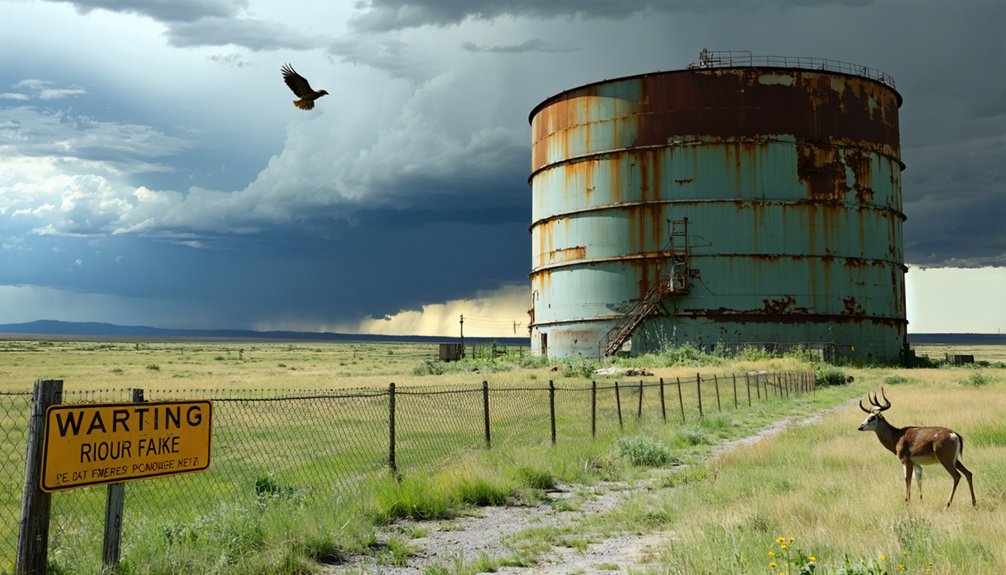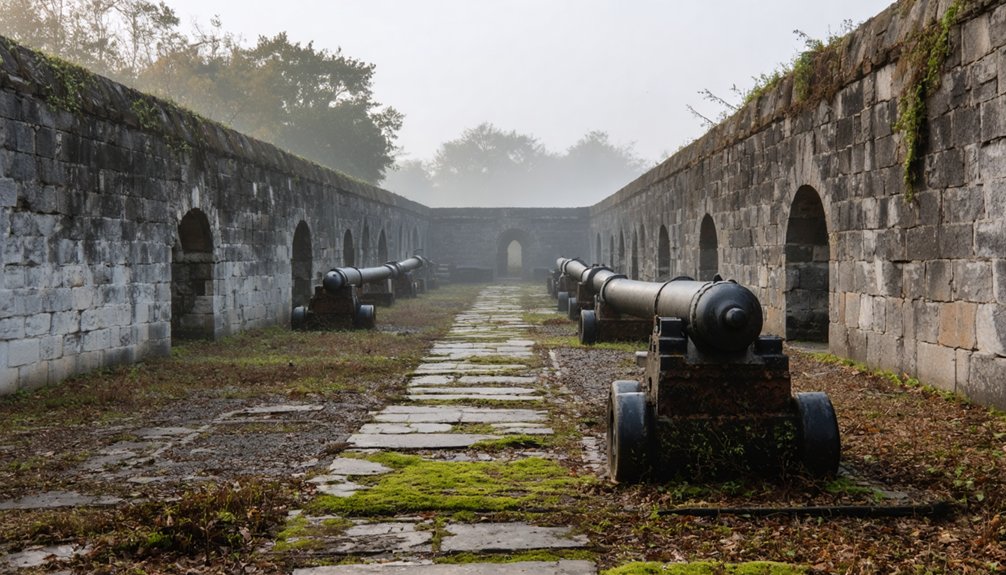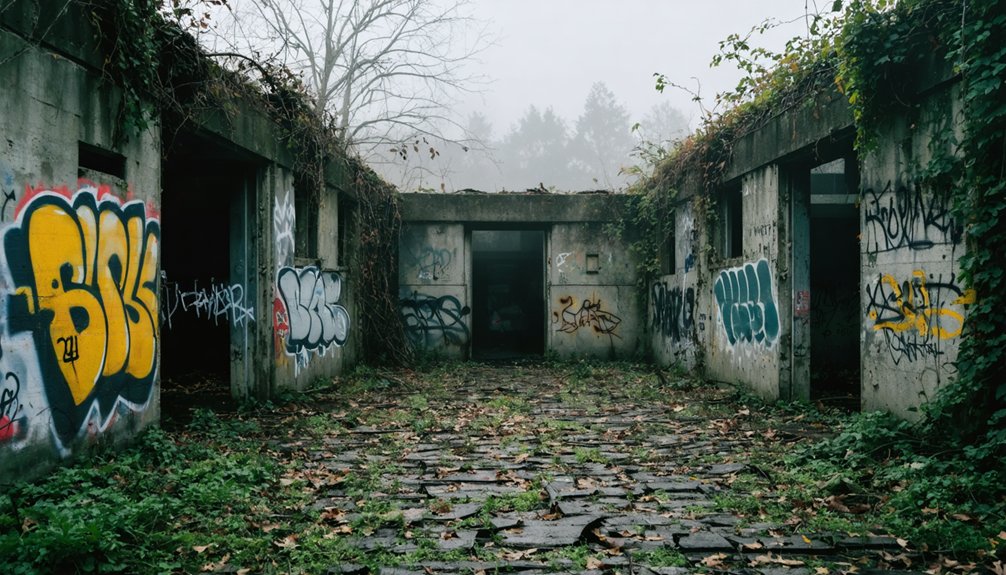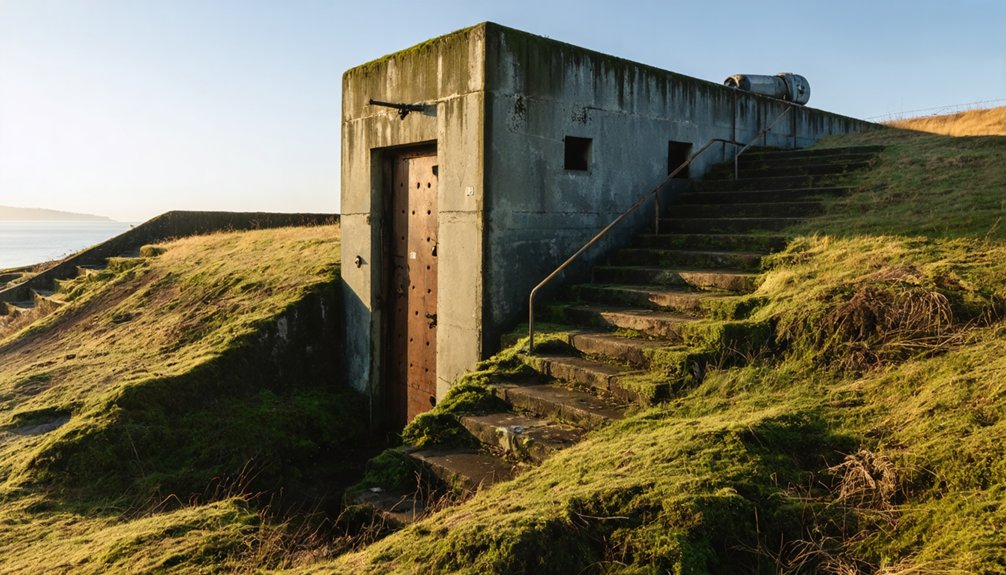Across America, you’ll find haunting abandoned military installations that tell stories of Cold War tensions, secret experiments, and environmental challenges. From Fort McClellan’s toxic chemical legacy in Alabama to the mysterious Montauk Air Force Station on Long Island, these bases harbor compelling histories. You can explore Fort Monroe’s massive stone fortress, Camp Hero’s sealed tunnels, and North Dakota’s $6 billion Nekoma missile complex. Behind their deteriorating walls and underground chambers lie tales of classified operations waiting to be uncovered.
Key Takeaways
- Fort McClellan’s toxic chemical legacy and reported illnesses create an eerie atmosphere at one of America’s most contaminated military sites.
- Camp Hero’s sealed tunnels, mysterious underground structures, and conspiracy theories about mind control experiments make it particularly haunting.
- The abandoned Nekoma Missile Base stands as a Cold War relic with its massive pyramid structure and empty missile silos.
- George Air Force Base’s contaminated grounds and hazardous chemicals have left a devastating environmental and health impact.
- Fort Monroe’s massive stone fortress, haunted reputation, and historical significance draw ghost hunters and history enthusiasts.
Montauk Air Force Station: The Mystery Behind Long Island’s Hidden Base
Deep within Long Island’s easternmost shores lies one of America’s most intriguing abandoned military installations: Montauk Air Force Station.
Originally established in 1942 as Camp Hero, this coastal defense station masqueraded as a fishing village to deceive potential German invaders during World War II.
During wartime, Camp Hero’s clever disguise as a humble fishing village helped shield America’s coast from Nazi threats.
You’ll find remnants of its military might in the form of massive gun batteries and radar installations that once protected American shores.
After the Army’s departure in 1947, the Air Force transformed the site into a critical radar surveillance post, operating until 1981.
The powerful radar systems could detect any suspicious aircraft or vessels from over 200 miles away, providing crucial intelligence during the Cold War period.
While officially deactivated in 1969, reports suggest underground facilities remained active for decades after.
Today, while conspiracy theorists whisper about the infamous Montauk mysteries and alleged underground experiments, the former base serves a peaceful purpose as Camp Hero State Park.
What was once a fortress of coastal defense now welcomes visitors to explore its historic grounds and remaining military structures.
Fort McClellan’s Chemical Legacy: A Ghost Town in Alabama
While Montauk Air Force Station harbors mysteries of coastal defense, Fort McClellan’s legacy tells a darker tale of chemical contamination.
You’ll find this abandoned Alabama base ranked among America’s most toxic military sites, rivaling Camp Lejeune in its environmental impact. From the 1950s through 1999, the installation housed the Army Chemical Corps School, where soldiers trained with chemical warfare agents amid an already contaminated environment from the adjacent Monsanto plant’s PCB releases. Over $3.2 billion in remediation efforts have been spent addressing these hazards in the Anniston area.
The toxic footprint remains through groundwater and soil, with PFAS, TCE, and other “forever chemicals” persisting decades later. Today’s veterans face ongoing health battles as medical testing reveals exposure to PCBs, chemical warfare agents, and radiological materials.
Veterans who served here report serious illnesses linked to chemical exposure, including cancer and immune disorders, yet struggle to receive VA recognition.
Despite EPA Superfund cleanup efforts, Fort McClellan stands as a stark reminder of military testing’s lasting environmental toll.
Nekoma Missile Base: North Dakota’s $6 Billion Cold War Pyramid
Rising from the North Dakota prairie like an ancient monument, the Stanley R. Mickelsen Safeguard Complex stands as a haunting reminder of Cold War nuclear anxiety. This $5.7 billion fortress operated for less than a year in 1975, yet played a significant role in U.S.-Soviet arms negotiations.
The site was the first of twelve planned facilities across the United States.
Deep beneath the surface, crews excavated nearly one million cubic feet of earth to create the facility’s underground infrastructure.
You’ll find its massive pyramid-shaped radar structure anchoring America’s only operational anti-ballistic missile system.
- 30 LIM-49 Spartan missiles and 70 Sprint interceptors stood ready to defend against Soviet ICBMs
- Advanced radar systems could track incoming threats hundreds of miles away
- Reinforced concrete and steel construction designed to survive nearby nuclear detonations
Today, this Cold War legacy sits abandoned, its silent silos and dormant radar arrays testifying to a time when nuclear confrontation seemed imminent.
While preservation efforts continue, the complex remains a stark monument to an era of superpower tension.
Camp Hero: Dark Secrets of the Coastal Defense Fortress
Standing sentinel on Long Island’s eastern tip, Camp Hero began its military service in 1942 as an ingeniously disguised coastal defense station protecting New York from Axis naval threats.
You’ll find its massive 90-foot radar tower, one of only 12 built nationwide and the last still standing, dominating the coastline – a Cold War relic that operated until 1981.
The base’s secretive nature and restricted underground areas spawned the infamous Montauk Project conspiracy theories, with claims of mind control experiments and time travel research. After the base’s deactivation in 1982, sealed tunnels and mysterious manhole covers fueled speculation about hidden laboratories.
While these stories remain unverified, Camp Hero’s authentic military history includes three powerful gun batteries and essential early-warning radar operations.
Today, you can explore this former fortress as a state park, though some bunkers and underground sections still remain sealed, keeping their Cold War secrets intact. Named in honor of Major General Andrew Hero, the base’s namesake died the same year it was commissioned.
Fort Tilden’s Silent Batteries: An Atlantic Guardian’s Last Stand
Perched along New York’s rugged Atlantic coast, Fort Tilden emerged in 1917 as an essential defense against German U-boats threatening America’s most populous harbor.
These silent guardians evolved through WWII and the Cold War, transforming from coastal artillery to nuclear-capable Nike missile installations twice as powerful as Hiroshima’s devastation.
Today, you’ll find concrete relics scattered throughout the grounds:
- Battery Harris’s massive gun casemates, encased in protective concrete in 1941
- Underground missile silos and launch pads, now buried beneath coastal dunes
- WPA-era military buildings, including powder rooms and control bunkers
Nature has reclaimed these Cold War remnants, with sand dunes and thick vegetation engulfing the structures.
Artists now utilize the abandoned military warehouses for contemporary art installations, breathing new life into these historic spaces.
Visitors can reach the site by taking the Q35 bus after the Gil Hodges Bridge.
While contamination from old munitions persists, the site stands as a haunting memorial to America’s coastal defense legacy.
George Air Force Base: California’s Haunted Desert Complex
You’ll find George Air Force Base’s haunted ruins sprawled across California’s High Mojave Desert, where it served as a critical Cold War pilot training facility from 1950 to 1992.
The base’s strategic location and extensive infrastructure made it an ideal training ground for tactical fighter pilots, though its legacy is now marred by reports of widespread toxic contamination affecting over 100,000 people.
As the abandoned buildings decay under the desert sun, numerous visitors have reported unexplained phenomena and paranormal activity within the base’s empty halls, adding a ghostly dimension to its already troubled history.
Strategic Cold War Location
Located deep within California’s Mojave Desert, George Air Force Base occupied a strategically vital position just 8 miles northwest of Victorville during the Cold War era.
You’ll find this desert fortress perfectly situated for Military Operations, offering vast unpopulated airspace that proved ideal for sensitive training missions and testing.
The base’s strategic advantages included:
- Extensive desert terrain providing natural security for classified Cold War Training
- Quick access to major transportation routes and nearby military installations
- Remote location ensuring operational secrecy while maintaining rapid response capabilities
The desert setting wasn’t chosen by accident – it was meticulously selected to maximize both defensive capabilities and training potential.
Its position within the designated defense region made it a significant asset for protecting America’s western frontier during periods of heightened international tension.
Toxic Environmental Legacy
While the desert location provided strategic advantages during the Cold War, George Air Force Base left behind a devastating environmental legacy that continues to plague the region today.
You’ll find the site riddled with toxic chemicals from decades of military operations – TCE and PCE from aircraft maintenance, benzene from fuel spills, and heavy metals from plating operations.
The groundwater tells an even darker story, with PFAS levels soaring to 1,725 times above EPA limits in 2018.
Despite $113 million spent on environmental remediation, the toxic exposure continues affecting veterans and families through cancer clusters, birth defects, and reproductive health issues.
The base’s 1990 Superfund designation confirms what many already knew – it’s one of America’s most contaminated military sites, requiring ongoing cleanup efforts.
Paranormal Activity Reports
Beyond the toxic legacy of George Air Force Base lies an equally unsettling dimension – its reputation for intense paranormal activity.
You’ll discover unexplained phenomena throughout the abandoned complex, from EVP recordings capturing whispered commands to shadow sightings of military personnel in the derelict corridors. The base’s haunted reputation stems from decades of military operations, medical trauma, and the emotional weight of service member sacrifices.
- Investigators have documented compelling EVP evidence, including robotic voices and responses to direct questions.
- The abandoned hospital and barracks regularly yield reports of apparitions, temperature drops, and equipment malfunctions.
- You’ll encounter unexplained sensory experiences like phantom footsteps, slamming doors, and intense feelings of unease in former family services buildings.
Underground Missile Silos: Hidden Dangers Beneath the Northern Plains
You’ll find dangerous remnants of America’s Cold War defense network hidden beneath the northern plains, where hundreds of missile silos now stand abandoned and flooded.
Behind their 110-ton blast doors, these concrete chambers extend up to 155 feet underground, harboring contaminated groundwater and radioactive materials from decades of housing nuclear missiles.
While some silos have undergone cleanup efforts costing over $121,000 each, many continue to pose environmental hazards as their sealed tunnels quietly deteriorate beneath rural farmland.
Flooded Tunnels Hide Secrets
Deep beneath the northern plains of America, abandoned missile silos harbor a growing threat as groundwater steadily infiltrates their underground chambers.
You’ll find these 80-foot-deep concrete behemoths scattered across Montana, North Dakota, and Wyoming, where flood risks have transformed them into waterlogged time capsules of the Cold War.
- Groundwater seepage combines with leftover rocket fuels and chemicals, creating complex environmental hazards that threaten surrounding areas.
- Former pump systems, once keeping these facilities dry, now lie silent as water fills secure bunkers and launch control centers.
- Structural deterioration accelerates as flooding weakens concrete walls and corrodes aging mechanical systems.
What you’re witnessing is nature’s slow reclamation of these Cold War relics, where rising water levels expose hidden dangers that military engineers never anticipated during their construction.
Radioactive Contamination Still Lingers
While early concerns about radioactive contamination from missile sites sparked widespread fears, extensive testing reveals a different reality at America’s abandoned Titan I complexes. You won’t find artificial radioactive materials like plutonium or americium at these sites – the radioactive legacy isn’t what you might expect.
Instead, the real contamination concerns stem from toxic industrial chemicals. You’ll discover dangerous levels of PCBs, asbestos fibers reaching 30% concentration in air samples, and carcinogenic sodium chromate from cooling systems.
These chemicals have taken their toll, with missile workers reporting higher rates of cancer than the general population. Groundwater testing shows troubling plumes of chlorinated solvents like PCE and TCE, while metal contamination from corroding structures continues to impact local water sources.
Today, ongoing monitoring tracks these persistent chemical threats.
Rocky Mountain Arsenal: From Chemical Weapons to Wildlife Refuge

Located just outside Denver, Colorado, the Rocky Mountain Arsenal stands as a remarkable example of environmental redemption, transforming from a World War II chemical weapons facility into a thriving wildlife refuge.
From 1942 to the 1980s, this site produced deadly chemical agents like sarin, mustard gas, and napalm, leaving behind severe contamination that earned it Superfund status.
Today, after extensive chemical cleanup efforts, you’ll find:
- Roaming herds of bison and deer across thousands of preserved acres
- Protected habitat for diverse wildlife, including raptors and waterfowl
- Public hiking trails and observation points designed for safe exploration
This wildlife transformation represents one of America’s largest conversions of a weapons facility to protected habitat, though some areas remain restricted due to residual contamination requiring ongoing monitoring.
Camp Bouse: Arizona’s Secret Tank Training Ground
Hidden in Butler Valley’s remote desert landscape, Camp Bouse emerged in August 1943 as one of World War II‘s most secretive military installations.
You’ll find its remains 15 miles east of present-day Bouse, Arizona, where over 5,500 carefully screened volunteers once trained with the classified Canal Defense Light (CDL) technology. These modified tanks, equipped with powerful strobing arc lamps, were designed to disorient enemy troops in night combat.
Under General Patton’s command, the 9th and 10th Tank Groups operated in complete secrecy, with censored mail and restricted transfers.
While most structures were removed after the war, you can still explore concrete foundations, rusted relics, and memorials that mark this historic site.
The Bouse Chamber of Commerce offers February tours, revealing Camp Bouse’s unique chapter in Arizona’s wartime history.
Fort Monroe: The Abandoned Citadel of Hampton Roads

Standing as America’s largest stone fortress, Fort Monroe dominated the entrance to Hampton Roads and Chesapeake Bay from 1819 to 2011.
Designed by Napoleon’s former engineer Simon Bernard, this massive hexagonal stronghold earned its nickname “Gibraltar of the Chesapeake” with 10-foot-thick stone walls and over 400 cannons guarding critical waterways.
Fort Monroe’s mighty stone walls and artillery arsenal made it an impregnable guardian of America’s vital eastern waterways.
You’ll find three defining aspects that make Fort Monroe remarkable:
- Its strategic role as a Union stronghold during the Civil War, launching the Peninsula Campaign and issuing the landmark “Contraband Decision”
- The innovative star-shaped design featuring a moat and Water Battery that could strike targets over a mile away
- A haunting reputation with ghost stories of mysterious phenomena along its cobblestone paths after dark
Fort Monroe’s military significance endured until its closure under BRAC in 2005.
Frequently Asked Questions
How Much Does It Cost to Legally Explore an Abandoned Military Base?
You’ll need $20-100 for guided tours, plus $50-200 for exploration permits. Don’t forget liability insurance ($20-100) and safety regulations may require protective gear. Additional travel costs vary by location.
Can Civilians Purchase Decommissioned Military Bases at Government Auctions?
Yes, you can purchase decommissioned military bases through government auctions, but you’ll face strict regulations, environmental assessments, and property ownership requirements. Military auctions often prioritize local development authorities over individual buyers.
What Happens to Classified Documents Left Behind in Abandoned Bases?
You’ll find that classified documents are typically destroyed or secured before base abandonment, but any left behind face recovery operations, environmental degradation, or unauthorized access, violating military document preservation protocols.
Are There Still Active Security Patrols at Abandoned Military Installations?
You’ll find minimal security measures at most abandoned bases – typically no active military patrols. Local police or private security might conduct occasional drive-by checks, but patrol frequencies are generally very limited.
How Many Abandoned US Military Bases Contain Unexploded Ordnance Today?
You’ll find hundreds of abandoned US military bases containing unexploded ordnance risks today, with the DoD actively monitoring over 130 major sites that pose significant military base safety concerns.
References
- https://en.wikipedia.org/wiki/List_of_former_United_States_Army_installations
- https://www.operationmilitarykids.org/abandoned-military-bases/
- https://thedesigninspiration.com/news/facts/these-15-abandoned-military-bases-will-leave-you-speechless/
- https://www.youtube.com/watch?v=pcX5nv0XhCA
- https://mybaseguide.com/abandoned-military-bases
- https://www.youtube.com/watch?v=_GXPCLi66xw
- https://en.wikipedia.org/wiki/Category:Closed_installations_of_the_United_States_Navy
- https://www.youtube.com/watch?v=qlafRXpqWvQ
- https://www.epa.gov/fedfacts/base-realignment-and-closure-act-sites
- https://www.youtube.com/watch?v=MYe6MXx_3rE



